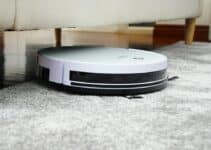Deep carpet cleaning refers to the process of thoroughly cleaning your carpets to remove dirt, stains, and allergens that have accumulated over time. While regular vacuuming is important for maintaining the cleanliness of your carpets, deep cleaning is necessary to remove deep-seated dirt and grime. Many people choose to hire professional carpet cleaners for this task, but it is also possible to do it yourself. DIY deep carpet cleaning has become increasingly popular due to its cost-effectiveness and convenience.
One of the main benefits of DIY deep carpet cleaning is that it allows you to save money. Hiring professional carpet cleaners can be expensive, especially if you have a large area of carpet to clean. By doing it yourself, you can save a significant amount of money. Additionally, DIY deep carpet cleaning allows you to have more control over the process and ensures that you are using safe and eco-friendly cleaning solutions.
Key Takeaways
- Deep carpet cleaning has many benefits, including removing dirt, allergens, and bacteria from your carpet.
- Choosing the right cleaning solution is important to ensure effective cleaning and avoid damage to your carpet.
- Preparing your carpet for deep cleaning involves vacuuming and spot treating any stains.
- DIY carpet cleaning tools and equipment include a carpet cleaner, vacuum, and cleaning solution.
- The step-by-step deep carpet cleaning process involves pre-treating stains, using the carpet cleaner, and allowing the carpet to dry completely.
Benefits of Deep Carpet Cleaning
Deep carpet cleaning offers several benefits that go beyond just making your carpets look clean. One of the main benefits is improved air quality in your home. Over time, carpets can accumulate dust, dirt, pet dander, and other allergens that can affect the air quality in your home. Deep cleaning removes these particles, resulting in cleaner and fresher air.
Another benefit of deep carpet cleaning is the removal of allergens and bacteria. Carpets can harbor allergens such as pollen, dust mites, and pet dander, which can trigger allergies and respiratory problems. Deep cleaning helps eliminate these allergens, making your home a healthier environment for you and your family.
Deep carpet cleaning also helps prolong the life of your carpet. Over time, dirt and debris can become embedded in the fibers of your carpet, causing them to wear down faster. By regularly deep cleaning your carpets, you can remove these particles and prevent premature wear and tear.
Lastly, DIY deep carpet cleaning saves you money in the long run. Regular deep cleaning helps maintain the condition of your carpets, reducing the need for costly repairs or replacements. By investing in a good carpet cleaning machine and regularly cleaning your carpets, you can extend their lifespan and save money in the long term.
Choosing the Right Cleaning Solution
When it comes to deep carpet cleaning, choosing the right cleaning solution is crucial. There are different types of cleaning solutions available on the market, each with its own set of advantages and disadvantages. It is important to consider factors such as the type of carpet you have, the level of dirt and stains, and any specific requirements or sensitivities you may have.
One option is to use commercial carpet cleaning solutions. These are specifically formulated to remove dirt and stains from carpets and are often more effective than homemade solutions. However, it is important to read the labels and choose a product that is safe for your specific type of carpet.
Another option is to make your own homemade cleaning solutions. These can be just as effective as commercial products and are often more eco-friendly. For example, a mixture of white vinegar and water can be used to remove stains and odors from carpets. Baking soda is another common ingredient that can be used to absorb odors and freshen up carpets.
When choosing a cleaning solution, it is important to test it on a small, inconspicuous area of your carpet first to ensure that it does not cause any damage or discoloration. Additionally, always follow the instructions provided by the manufacturer or recipe when using a cleaning solution.
Preparing Your Carpet for Deep Cleaning
Before you begin deep cleaning your carpet, there are a few steps you need to take to prepare it. First, start by thoroughly vacuuming the carpet to remove any loose dirt and debris. This will make the deep cleaning process more effective by allowing the cleaning solution to penetrate deeper into the fibers.
Next, remove any furniture or obstacles from the area you will be cleaning. This will make it easier to maneuver the carpet cleaning machine and ensure that all areas of the carpet are cleaned evenly. If there are any large or heavy furniture pieces that cannot be moved, consider using furniture sliders to protect both the furniture and the carpet.
If you have any visible stains on your carpet, it is important to spot clean them before deep cleaning. Use a stain remover or a homemade solution to treat the stains and allow them to sit for a few minutes before blotting them with a clean cloth or paper towel. This will help loosen the stain and make it easier to remove during the deep cleaning process.
DIY Carpet Cleaning Tools and Equipment
To effectively deep clean your carpets, you will need a few essential tools and equipment. The most important tool is a carpet cleaning machine, also known as a carpet extractor or steam cleaner. These machines use hot water and cleaning solution to deep clean carpets by spraying the solution onto the carpet and then extracting it along with the dirt and debris.
When choosing a carpet cleaning machine, consider factors such as its size, weight, and features. Look for a machine that is easy to maneuver and has adjustable settings for different types of carpets. Additionally, check if the machine has attachments or accessories that can be used for spot cleaning or reaching tight corners.
In addition to a carpet cleaning machine, you will also need brushes or scrubbers to agitate the carpet fibers and help loosen dirt and stains. These can be handheld brushes or attachments that come with the carpet cleaning machine. Choose brushes with soft bristles to avoid damaging the carpet fibers.
Lastly, you will need cleaning solutions and detergents to use with your carpet cleaning machine. As mentioned earlier, you can choose between commercial products or homemade solutions. It is important to follow the instructions provided by the manufacturer or recipe when mixing and using these solutions.
Step-by-Step Deep Carpet Cleaning Process
Now that you have all the necessary tools and equipment, it's time to start the deep carpet cleaning process. Follow these step-by-step instructions to ensure a thorough and effective clean:
1. Pre-treat stains: Before using the carpet cleaning machine, pre-treat any visible stains on your carpet. Apply a small amount of stain remover or homemade solution to the stain and allow it to sit for a few minutes. Gently blot the stain with a clean cloth or paper towel to remove as much of it as possible.
2. Prepare the carpet cleaning machine: Fill the tank of the carpet cleaning machine with hot water and the recommended amount of cleaning solution or detergent. Follow the instructions provided by the manufacturer for the specific machine you are using.
3. Start cleaning: Begin by cleaning the area farthest from the entrance and work your way towards it. This will prevent you from stepping on freshly cleaned areas. Slowly push the carpet cleaning machine over the carpet, making sure to overlap each pass to ensure even cleaning.
4. Agitate the carpet fibers: If your carpet cleaning machine has a brush or scrubber attachment, use it to agitate the carpet fibers as you clean. This will help loosen dirt and stains and make them easier to remove.
5. Extract the dirt and solution: As you push the carpet cleaning machine over the carpet, it will spray hot water and cleaning solution onto the carpet and then extract it along with the dirt and debris. Make sure to go over each area multiple times to ensure thorough extraction.
6. Rinse the carpet: Once you have finished cleaning, go over the entire carpet again with just hot water in the tank of the carpet cleaning machine. This will help remove any remaining cleaning solution or detergent from the carpet.
7. Drying the carpet: After deep cleaning, it is important to allow your carpets to dry completely before walking on them or replacing furniture. Open windows or turn on fans to help speed up the drying process. Avoid walking on the carpet until it is completely dry to prevent any dirt or debris from being tracked onto it.
Tips for Removing Stubborn Stains
While deep carpet cleaning can effectively remove most stains, there are some stubborn stains that may require extra attention. Here are some tips for removing common types of stains:
– For food and beverage stains, blot the stain with a clean cloth or paper towel to remove as much of it as possible. Then, mix a solution of white vinegar and water and apply it to the stain. Blot the stain again until it is removed.
– For pet stains, start by blotting up any excess urine or feces with a clean cloth or paper towel. Then, mix a solution of hydrogen peroxide and dish soap and apply it to the stain. Blot the stain until it is removed.
– For oil-based stains, such as grease or makeup, sprinkle baking soda on the stain and let it sit for a few minutes. Then, use a clean cloth or paper towel to blot the stain until it is removed.
– For red wine stains, immediately blot up as much of the wine as possible with a clean cloth or paper towel. Then, mix a solution of hydrogen peroxide and dish soap and apply it to the stain. Blot the stain until it is removed.
If these methods do not work, consider using a commercial stain remover specifically designed for the type of stain you are dealing with. Always follow the instructions provided by the manufacturer when using these products.
Drying and Maintaining Your Cleaned Carpet
After deep cleaning your carpets, it is important to properly dry them to prevent mold and mildew growth. Here are some drying methods you can use:
– Open windows: If weather permits, open windows in the room to allow fresh air to circulate and help dry the carpet faster.
– Use fans: Place fans around the room to help circulate air and speed up the drying process. Point the fans towards the carpet to direct airflow.
– Use dehumidifiers: If you live in a humid climate, consider using dehumidifiers to remove excess moisture from the air and help dry the carpet.
To prevent mold and mildew growth, make sure the room is well-ventilated and avoid placing furniture back on the carpet until it is completely dry. Additionally, regularly vacuum your carpets to remove any dirt or debris that may accumulate.
Alternative Deep Carpet Cleaning Methods
While DIY deep carpet cleaning using a carpet cleaning machine is the most common method, there are also alternative methods you can consider:
– Dry cleaning: Dry cleaning involves using a dry cleaning powder or foam that is applied to the carpet and then vacuumed up. This method is quick and does not require any drying time, but it may not be as effective at removing deep-seated dirt and stains.
– Steam cleaning: Steam cleaning uses hot water and steam to deep clean carpets. It is effective at removing dirt and stains, but it requires a longer drying time compared to other methods.
– Shampooing: Shampooing involves applying a carpet shampoo to the carpet and then using a brush or scrubber to agitate the fibers. The shampoo is then rinsed out using a carpet cleaning machine or by blotting with a clean cloth or paper towel.
Each of these methods has its own advantages and disadvantages, so it is important to consider factors such as the type of carpet you have, the level of dirt and stains, and your personal preferences when choosing a deep cleaning method.
Conclusion and Final Thoughts on DIY Deep Carpet Cleaning
In conclusion, DIY deep carpet cleaning offers several benefits, including improved air quality, removal of allergens and bacteria, prolonging the life of your carpet, and saving money in the long run. By choosing the right cleaning solution, preparing your carpet properly, using the right tools and equipment, following a step-by-step process, and taking care of stubborn stains, you can achieve a thorough and effective deep clean.
Remember to properly dry and maintain your cleaned carpet to prevent mold and mildew growth. Consider alternative deep cleaning methods such as dry cleaning, steam cleaning, or shampooing if they better suit your needs. With the right knowledge and tools, DIY deep carpet cleaning can be a cost-effective and convenient way to keep your carpets clean and fresh. So why not give it a try and see the difference it can make in your home?
FAQs
What is DIY deep carpet cleaning?
DIY deep carpet cleaning refers to the process of cleaning carpets using homemade or readily available cleaning solutions and equipment without the help of professional cleaners.
What are the benefits of DIY deep carpet cleaning?
DIY deep carpet cleaning is cost-effective, convenient, and allows you to customize the cleaning process to suit your specific needs. It also helps to remove dirt, stains, and allergens from your carpets, making them look and feel fresh and clean.
What are some common DIY deep carpet cleaning strategies?
Some common DIY deep carpet cleaning strategies include using baking soda, vinegar, or hydrogen peroxide solutions, steam cleaning, and using a carpet shampooer or extractor.
What equipment do I need for DIY deep carpet cleaning?
The equipment you need for DIY deep carpet cleaning includes a vacuum cleaner, a carpet shampooer or extractor, a steam cleaner, cleaning solutions, and a scrub brush.
How often should I deep clean my carpets?
It is recommended to deep clean your carpets at least once a year. However, if you have pets, children, or high traffic areas, you may need to deep clean your carpets more frequently.
What are some tips for DIY deep carpet cleaning?
Some tips for DIY deep carpet cleaning include vacuuming your carpets thoroughly before cleaning, testing cleaning solutions on a small, inconspicuous area first, and allowing your carpets to dry completely before walking on them.




